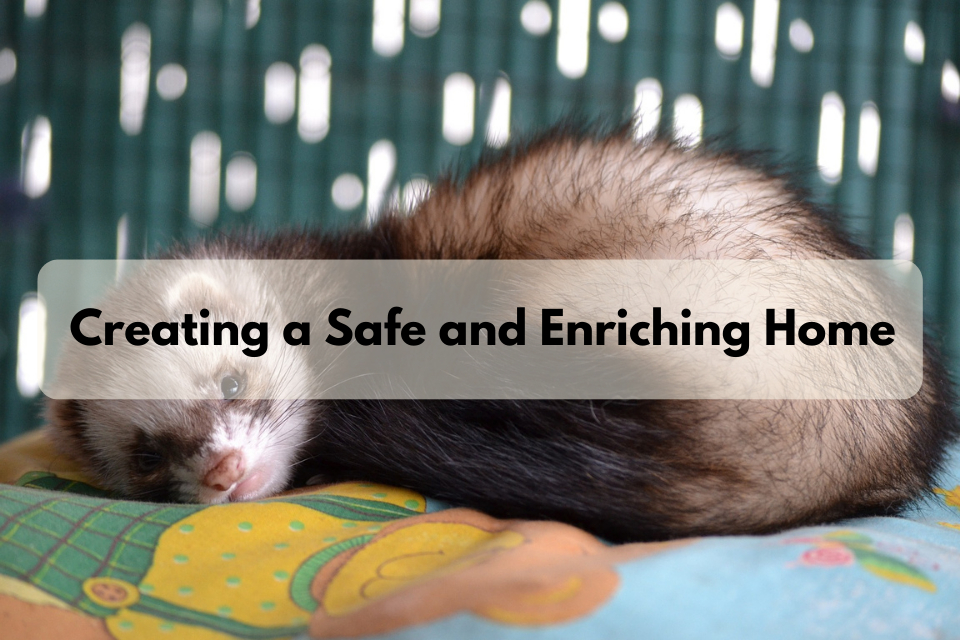A well-designed cage and habitat are essential for the health and happiness of your pet ferret. Creating the ideal living environment involves careful consideration of factors such as cage size, bedding materials, enrichment options, and safety measures. In this comprehensive guide, we will explore the key elements of setting up a ferret cage and habitat, providing you with valuable insights and practical tips to ensure your ferret thrives in a space that meets their physical and behavioural needs.

Cage Size and Setup
To ensure your ferret has enough space to move and play, it’s crucial to choose an appropriately sized cage. Consider factors like the number of ferrets, their activity levels, and the cage’s dimensions. Provide multiple levels and platforms to encourage climbing and exploration. Additionally, include essential items such as litter boxes, food and water bowls, and comfortable bedding.
Bedding and Substrate
Choosing the right bedding material is vital for your ferret’s comfort and hygiene. Opt for dust-free, absorbent bedding options like paper-based bedding or fleece liners. Avoid cedar or pine shavings, as they can be harmful to ferrets’ respiratory systems.
Enrichment and Toys
Ferrets are highly intelligent and curious animals that require mental stimulation and enrichment. Provide a variety of toys, tunnels, and interactive games to keep them entertained. Rotate toys regularly to maintain their interest, and consider puzzle feeders to stimulate their problem-solving skills.
Safety Measures
Ferrets are skilled escape artists, so it’s essential to ensure their habitat is escape-proof. Regularly check the cage for any gaps or weak points that could allow them to squeeze through. Remove any hazardous items, such as toxic plants or small objects that they could swallow. Cover electrical cords and secure them out of reach to prevent accidents.
Cleaning and Hygiene
Maintaining a clean and hygienic environment is crucial for your ferret’s health. Clean the cage regularly, removing waste, and disinfecting surfaces. Wash bedding and toys regularly as well. Use pet-safe cleaning products and ensure proper ventilation to prevent the buildup of ammonia fumes.
Social Interaction and Exercise
While a cage provides a safe home base, ferrets also need ample time outside the cage for social interaction and exercise. Set up a designated play area or use ferret-proofed rooms for supervised playtime. Provide tunnels, climbing structures, and hiding spots to create an enriching environment outside the cage.
Conclusion
Creating a suitable cage and habitat for your ferret is essential for their overall well-being. By considering cage size, bedding materials, enrichment options, safety measures, and providing ample social interaction and exercise, you can ensure your furry friend has a comfortable and stimulating home. Implement the tips outlined in this guide to create the ultimate ferret living space and enjoy a harmonious bond with your playful companion.
Here are 10 frequently asked questions about ferret cages and habitats along with their answers
- Q: What size cage is suitable for a ferret? A: A ferret cage should be at least 2 feet by 3 feet in floor space, with multiple levels and platforms to accommodate their active nature.
- Q: Can I use a rabbit or guinea pig cage for my ferret? A: It’s not recommended, as ferrets are skilled escape artists. Ferret-specific cages have narrower bar spacing and are designed to prevent escapes.
- Q: What bedding material is safe for ferrets? A: Ferrets do well with paper-based bedding or fleece liners. Avoid cedar or pine shavings, which can be harmful to their respiratory systems.
- Q: How often should I clean the ferret cage? A: Ferret cages should be cleaned at least once a week, with litter boxes scooped daily. Regular cleaning helps maintain hygiene and prevents odors.
- Q: Can I use clay or clumping cat litter in the ferret’s litter box? A: No, ferrets should not use clumping or clay cat litter as it can be harmful if ingested. Use a dust-free, low-dust, non-clumping litter made for ferrets.
- Q: What toys are suitable for ferrets? A: Ferrets enjoy interactive toys like tunnels, balls, and puzzle feeders. Avoid toys with small parts that could be swallowed or pose a choking hazard.
- Q: Is it necessary to ferret-proof the entire house? A: Ferret-proofing is essential for their safety. Start with a designated play area, but gradually ferret-proof other rooms to allow supervised exploration.
- Q: Can ferrets be kept in outdoor cages? A: Ferrets are sensitive to temperature extremes and can overheat or become too cold in outdoor cages. It’s best to keep them indoors in a controlled environment.
- Q: Should I cover the ferret cage at night? A: Ferrets prefer a dark and quiet sleeping environment. Covering the cage partially or fully can help create a cozy sleeping area for them.
- Q: Can I keep multiple ferrets in the same cage? A: Yes, ferrets are social animals and often enjoy the company of other ferrets. Ensure the cage is spacious enough to accommodate multiple ferrets comfortably.
Remember, providing a suitable cage and habitat is crucial for your ferret’s well-being. If you have additional questions or concerns, consult with a veterinarian or ferret expert for personalized guidance.





